You’ve taken the time to do the research and have made the important decision to go solar in order to completely offset your monthly utility bill. The next big question that comes up is how to know how many solar panels your home will need to achieve your goal.
The average home generally needs somewhere between 20 – 24 rooftop solar panels in order to be completely solar powered and not grid-reliant. There’s a formula that the solar panel industry uses to determine how many panels a home will need. You take the system size and divide it by the production ratio, which is then divided by the wattage of the panels.
As with everything else related to solar power and solar panels, there are many contributing factors that come into play, such as the individual panel specifications and your home’s geographic location. Keep reading for a full download of information!
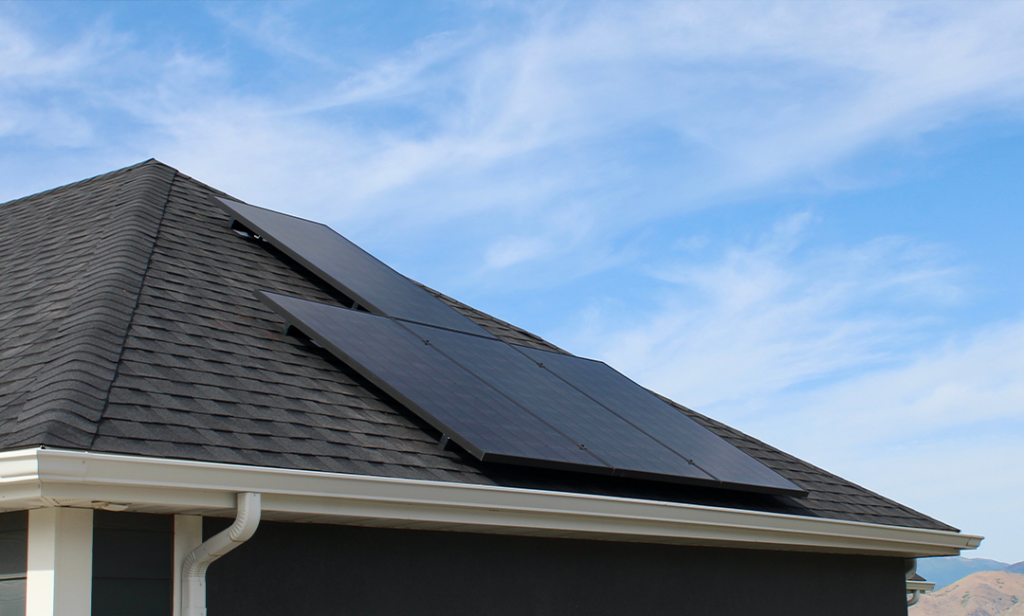
How Many Rooftop Solar Panels Should I Have Installed?
Our customers ask us this question daily. It’s a very important question, as the number of solar panels you’ll need directly impacts your initial financial investment and purchase. Our answer to how many solar panels you’ll need installed is rarely cut and dry because there are so many factors that go into this decision.
First, an important consideration is how much you want to pay for your solar installation. The more rooftop solar panels you need, the greater your initial expense is going to be. Next is the efficiency of the solar panels you choose. The higher efficiency the panels, the greater their purchase price.
Yours and your family’s energy usage habits also play a big role in deciding how many solar panels you’ll need. Your home’s geographic location, both in the country, and its directional orientation also affect the number of solar panels needed.
So, while the average home will need between 20 – 24 rooftop solar panels in order to have an effective solar energy system, each individual home will be different.
Calculating How Many Solar Panels You’ll Need
There are a couple of ways you can go about figuring out the exact number of solar panels your home will need. The easiest way that doesn’t involve a lot of time-consuming math is a tool called a solar calculator. The other way is to use the formula we mentioned above.
Solar Calculator
If you don’t feel like doing the math in order to figure out the exact number of solar panels you’ll need, you can also use a solar calculator. EnergySage is a great resource in the solar world, and they offer an excellent solar calculator. This way you simply put in your address and an estimate of your monthly electric/power bill, and the solar calculator does the rest.
Solar Panel Formula
We mentioned a formula earlier that’s used to help determine how many solar panels your home will need. To reiterate that, you’ll figure out the total size of the system, divide that by the production ratio, and then divide that number by the panel wattage.
( [ Total Size of System ] / [ Production Ratio ] ) / [ Panel Wattage ] = # Panels Needed
The Three Key Components of the Formula
When we talk with our customers about how many solar panels will be needed to fully power their home, we’re taking three main things into consideration. The first is annual electricity usage. The second is the wattage of the actual panels being used. And the third is something called the production ratio. We’ll go into more depth on this, as these three things are really important.
Annual Electricity Usage
Knowing how much electricity you use annually is really important when deciding how many solar panels your home will need. Every appliance in your home uses some amount of electricity. You’ve got air conditioning units, heaters, refrigerators, washers, dryers, lights, phone chargers, etc. that are contributing to your annual electricity usage.
Electricity usage is measured in kilowatt-hours (kWh). Simply put, your annual electricity usage is how much electricity (or energy) you’re using in your home over a year’s span.
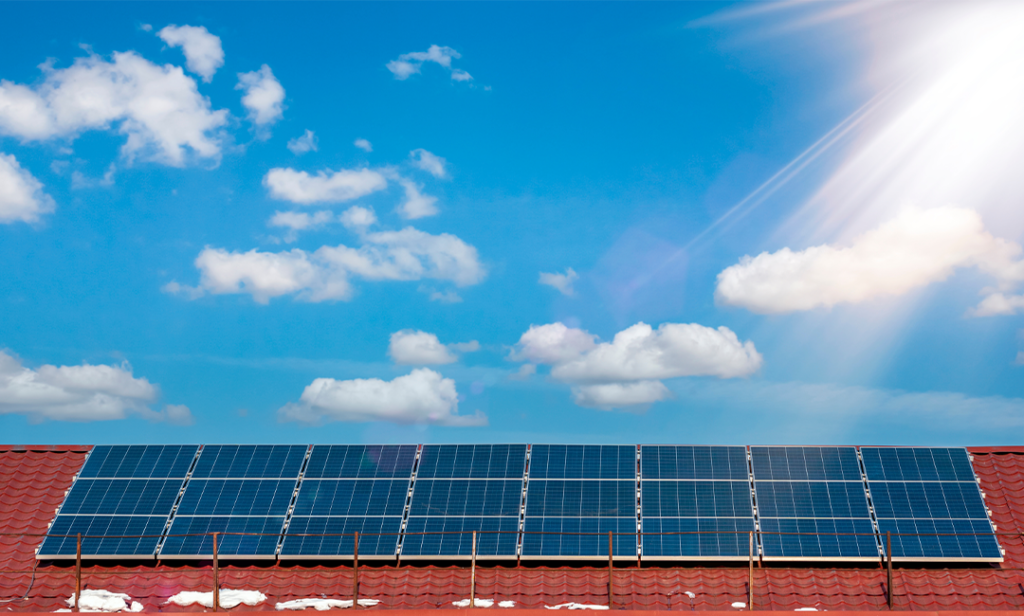
Average Amount of Electricity Used in American Households
The U.S. Energy Information Administration (EIA) studies things like energy usage and various forms of power. In a recent study, the EIA determined that the typical American household uses about 10,715 kWh of electricity.
Electricity Usage Determines Your Solar Array Size
If we use the EIA’s number of 10,715 kWh as the average American household’s electricity usage, we can take that to help us figure out what your ideal number of solar panels would be. When our clients make the decision to go solar, their goal is usually to offset all of their electricity costs and to be 100% solar powered.
Getting More Precise Estimates on Energy Usage
We mentioned the U.S. Energy Information Administration’s study and the average kWh most Americans use. However, there’s a more accurate way to figure out your energy usage. You would need to go through all the previous year’s electric/utility bills and write down the exact amount of electricity your house used. Later in the article we’ll give you some equations that you can plug this number into, which will then give you your exact usage.
Solar Panel Wattage
Every solar panel on the market will have a slightly different wattage, or electricity output. Another way to describe solar panel wattage is to talk about it in terms of the particular panel’s power rating.
Average Solar Panel’s Power Rating
We measure wattage in units of watts (W). The majority of solar panels on the market put out somewhere between 250-400 W of power, so we’ll call the average solar panel wattage 340 W.
EnergySage as an incredibly useful online resource for solar power and panel education that we like to refer our clients to. On their Marketplace, they list and describe a bunch of the solar panels on the market. The most popular solar panels all put out at least 340 W, so that’s the number we’ll use in this article.
Production Ratios
Your house’s geographic location, both in terms of the region of the country you’re in, as well as what direction your roof primarily faces, both affect your solar panels’ production ratio. This is a direct result of the amount of sunlight hitting your solar panels.
The production ratio of your solar panel system takes into account the actual size of the whole system (measured in W), as well as its estimated energy output over a period of time (which is measured in kWh). You will never get a 1:1 ratio, simply because no two houses get identical amounts of sunlight hitting their rooftop solar panels.
An Example Production Ratio
Since Convert Solar is a U.S. company, we’re going to use numbers for typical U.S. households and their production ratios. We see production ratios falling somewhere between 1.3 and 1.6.
Let’s say you have a 10 kWh system that is regularly producing 14 kWh of electricity each year. Your solar system’s production ratio would be 1.4. You would take 14 kWh and divide it by your 10 kWh system, getting you a production ratio of 1.4.
Using the Math to Figure Out the Number of Solar Panels You’ll Need
Energy use, solar panel wattage, and production ratios are the three determining factors that will tell you how many solar panels you need for your house. But how does it work?
Number of panels needed = system size/production ratio/panel wattage
Let’s Put In the Numbers
Number of panels needed = 10,715 kWh/1.3 or 1.6/340 W
Remember at the beginning of the article we said that an average house will need 20 – 24 solar panels? This formula is what gave us that estimated number. If we use a production ratio of 1.6, we find out that we’ll need 20 solar panels, and if we use the production ratio of 1.3, we’ll need 24 solar panels.
So What’s the Total System Size?
We’ll use our 20 solar panel system as the example here. If each of those 20 panels produces 340 W, you’re going to have a 6.8 kWh system!
Recap of What Determine the Number of Solar Panels You’ll Need
Annual energy usage, solar panel wattage, and production ratios are the bigger components in determining how many solar panels you’ll need. However, that’s not the whole picture.
When you’re doing your research to figure out your ideal solar panel system size, you’ll also want to consider how big your house is, where it’s located, how dependent you plan to be on solar power, or if you plan on also being grid-tied, among other things.
How Much Power (kWh) My Solar Energy System Produces
Remember production ratios? Your production ratio is directly tied to how much power your solar energy system can produce. And the amount of sunlight exposure your roof gets is what dictates your production ratio. So, to summarize, how many kWh your solar system produces is completely dependent on how much sunlight hits your roof.
Solar Radiation/Sunny Days and Power Production
One of the more common questions we get is “will solar still work if I live in a region with more cloudy days than sunny ones?” Our answer is “absolutely, yes!” Convert Solar is based in Virginia Beach, VA and we see our fair share of cloudy, rainy weather, but that shouldn’t stop you from going solar. This is because as long as it’s daylight, there’s going to be some amount of solar radiation reaching your rooftop solar system, which in turn is going to cause your solar panels to produce power.
Going back to production ratios and the affect sunlight has on that ratio, there will be times of the day/year in which it’s easier for your panels to produce power. Likewise, if you live in Arizona you’ll see more sunny days than if you live in Maine or Virginia.
Production Ratios and How Many Solar Panels You’ll Need
Since your production ratios are directly affected by the amount of sunlight your solar panels are getting, it would make sense that your production ratios also dictate the number of solar panels you’ll need to have installed.
If your regional location has less sunny days, your production ratios will be lower, meaning you’ll need to install more solar panels. Conversely, if you’re in a region with plentiful sun, your production ratios will be larger, meaning you won’t need as many solar panels.
Basically, you’ll need to look at your production ratios, determine how much power you need, and then buy the appropriate number of solar panels to meet your particular power/energy needs.
Sunlight Exposure vs Number of Panels Needed
We’ve already talked about how productions ratios are affected by sunlight, and how that in turn determines how many solar panels you’ll need. So let’s look at an a couple of examples using the numbers we got earlier.
Your average household in the U.S. consumes about 10,715 kWh each year. One household is going to be in Arizona and the other is going to be in Virginia.
Arizona House
In order for the Arizona household to be 100% solar powered with all their energy needs met, they’ll need a solar system that produces about 6.8 kW. This is due to their high production ratio.
Virginia House
The Virginia household also wishes for 100% of their energy needs to be met with solar power. Since Virginia overall has less peak sunlight hours than Arizona, this household will need a system that produces about 8.2 kW to make up for their lower production ratio.
Solving the Disparity with Number of Solar Panels
Alright, so we know that the house in Arizona has more sunlight exposure, and thus a higher production ratio. The Virginia house has less sunlight exposure and a lower production ratio. The Arizona house will need a smaller solar energy system than the Virginia house.
This might sound like a problem and could be discouraging, but we tell our clients that this problem isn’t in fact a problem. It simply means that if you live in an area with less sunlight, you’ll just need a solar energy system with more panels, or higher efficiency panels. Your power needs can be met just as easily and completely as those of a household in a sunnier region.
The Number of Solar Panels You’ll Need Depends on the Size of Your System
The average American house needs a system that produces around 6.8 kW in order for all of its energy needs to be met. This number is dependent on an area with a production ratio of 1.6. We realize those numbers won’t be accurate for all regions across the U.S.
Like we’ve mentioned, if you’re in a really sunny region, your production ratio will be on the higher side, so 1.6 is accurate. But if you’re in a region that’s further north and/or less sunny, your production ratio would be closer to 1.3 and you’d need more solar panels in order to meet your energy needs.
Simply put, the smaller your system, the fewer solar panels you’ll need to meet your home’s energy needs. The larger your system, the more solar panels you’ll need in order to meet those same energy requirements.
The following table is a great reference for figuring out how your system size relates to number of panels needed and what the estimated annual production will be. Something to note though is that this table assumes the solar panels are 340. Some of these numbers will change depending on what efficiency panels you’re using.
Number of solar panels needed for specific system sizes
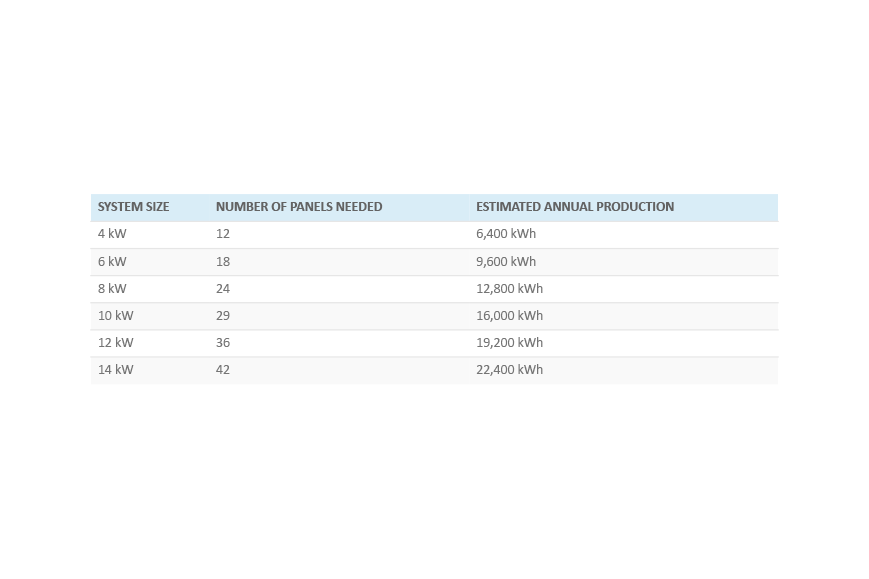
The next table gives you an idea of how much rooftop real estate your solar panel system will take up. Something to keep in mind is that the power output of your chosen panels will play a big role in how much space they take up.
Square footage of different size solar panel systems
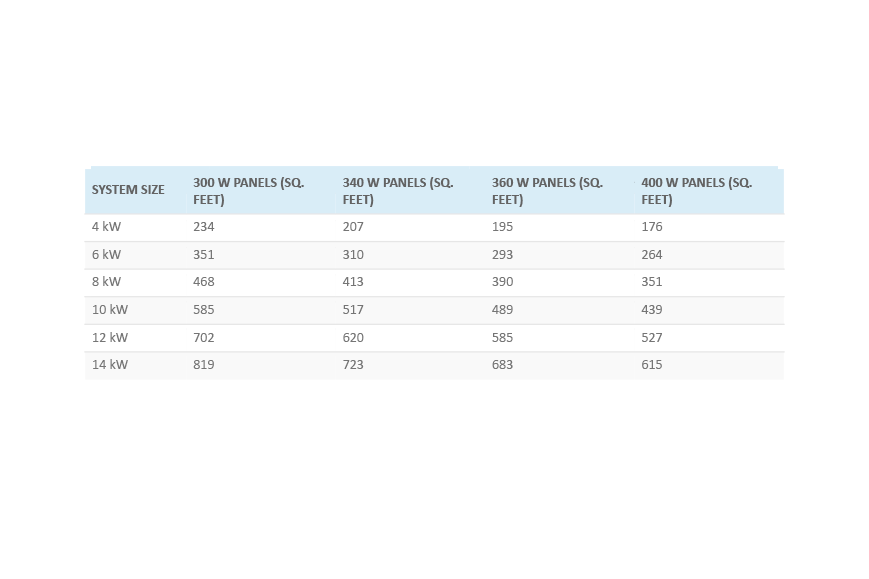
Accurately Estimate Your Household’s Annual Energy Usage
This is really important because the size of your solar panel array (system) is going to depend on how much energy your household uses. You’ll want to figure out the amount of energy the various products in your house use.
Larger Products = More Energy Use = More Solar Panels Needed
Some examples of household products that will really impact the size of your solar array and require more panels are:
- A central air conditioning system
- A heated swimming pool
- Electric cars
Remember: the larger the energy using products in your house, the greater your annual kWh requirements will be.
Other Considerations That Affect Size and Number of Solar Panels
Not all homes are built the same. They’ll be different sizes, have different shaped roofs, and be oriented in different directions.
Homes with Large Roofs
If your house has a big roof, you can get some pretty large solar panels. While the larger panels might mean you sacrifice a little bit of efficiency, you’ll be guaranteed to get the energy output you need.
Homes with Small or Strangely Shaped Roofs
These houses require a little more planning when it comes to what kind of solar panels you’ll need, as well as how many you’ll need. You’re obviously going to need fewer solar panels than for a house with a huge roof. You’ll also very likely want to consider high efficiency panels in order to get your home’s power and energy needs met.
So How Big is an Average Solar Panel Anyway?
Solar panels come in a variety of sizes, often depending on the type of panel you’re looking at. Also, panel size is closely related to their efficiency rating. The higher efficiency panels will generally be smaller, and the lower efficiency panels might be larger. That’s a very generalized way of thinking about it.
With those factors in mind, you can still get an idea of the average size of solar panels that we use on most houses today. They’re going to be about 5.4 feet x 3.25 feet (or 65 in x 39 in).
How the Size of My House Determines How Many Solar Panels I’ll Need
The easiest way to think about this question is to use your house’s square footage as a guide to how many solar panels you’ll need in order to meet 100% of your power needs. For example, the larger your house, the more solar panels you’ll need.
The dimensions of solar panels haven’t really changed over the years, but the amount of power they can produce has increased exponentially. In other words, solar panels have become a lot more efficient.
You’ll notice that the good solar panel manufacturers have worked hard to make the whole rooftop solar system more aesthetically pleasing and efficient. They’ve done this by using invisible framing, closing any gaps between individual panels, and using top of the line mounting hardware.
Home square footage compared to the number of solar panels needed

Will My Household Appliances Affect How Many Solar Panels I Need Installed?
Yes! Every appliance and product in your house that requires electricity will directly affect how much power you’ll use/need, and this in turn will determine how many rooftop solar panels you’ll need.
One of the first things you’re going to want to do when researching types of solar panels is to figure out the kWh requirements of your household appliances and products. If you want a great informative article on how much power a washing machine uses, check out that link.
Like we already mentioned, certain things will dramatically increase your power usage and needs. Electric vehicles are one of those things. Though electric vehicles, just like solar power, are great when it comes to reducing carbon emissions, they do require a lot of power to keep going. This means your PV system will likely be twice as big as if you didn’t have an electric vehicle.
Can’t I Just Add More Solar Panels Later?
It’s pretty common for customers to go with a particular solar energy system setup that might save them a little money on the initial purchase and install. While there’s nothing wrong with this, the problem they run into later on is that they’re finding they’re still getting a hefty monthly electric bill. This is because their energy/power needs are greater than what their solar energy system can produce.
So How Do You Avoid This Pitfall?
The best way to make sure your solar energy system will meet (and even exceed your monthly energy requirements) is to look closely at the appliances and products you’re running on a regular basis. The most common of these would be: central air conditioning, swimming pools, electric cars, refrigerators, and hot tubs.
Your solar installer can then help you select the solar energy system that will best meet your needs in the long run.
This is a helpful table that gives accurate estimates on the average annual amount of electricity these appliances need, and the corresponding number of solar panels that would meet those needs.
Solar panel requirements for individual appliances
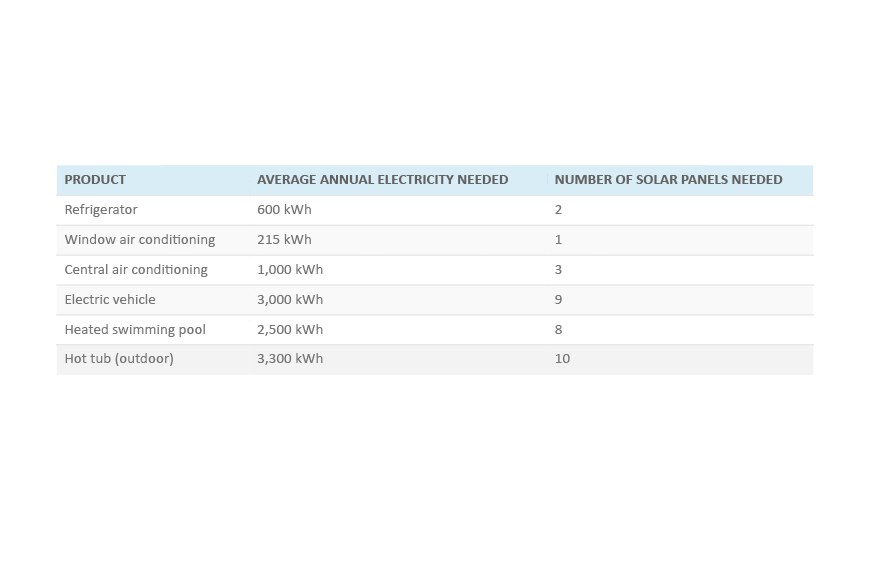
Frequently Asked Questions
Going solar is a big decision. Since we advocate client knowledge and thorough research, we like to give our clients as much information as possible. Here are some of the more commonly asked questions by clients considering a solar panel installation.
Will I Still Get an Electricity Bill After I’ve Installed My Solar Panels?
Installing solar panels doesn’t remove your electricity bill. You’ll still get one each month, but you’ll notice that the amount is significantly lower, if not at or below zero.
There are instances when people’s electric bill stays the same or goes even higher. The typical cause of this is if you’ve added a lot of high-energy-using appliances that have drastically increased your electricity load. Also, it could be possible that the size of your solar system simply isn’t big enough. Once you make the necessary adjustments, you’ll see that your solar system will pay for itself and get your electricity bill reduced or eliminated.
What Are Some Potential Disadvantages to Having My Home Powered By Solar Panels?
There are really only two disadvantages that we’ve seen with choosing to use solar energy. The first is that the initial purchase and installation costs are pretty high. However, it doesn’t take long before the solar system has more than paid for itself.
The second disadvantage to going solar is that solar power can be intermittent. What this means is that your panels can only absorb solar radiation during daylight hours. They aren’t producing solar power at night. The solution to this issue is a backup battery storage system. This way, all the excess power that your panels generate during the day is stored in these batteries, which gives you uninterrupted power throughout the night.
Is Going Solar Worth It?
Yes, absolutely! We know that there is a lot of factors going into the decision to go solar, and it’s not one to be taken lightly. But we think the benefits of solar power far outweigh any of the downsides.
Some of the biggest things clients site when they tell us why they want to go solar are: high electricity and utility bills; their energy needs/usage; a desire to power their home in a more environmentally friendly way; and the actual regional and geographic location of their house.
Just to reiterate, the purchase and installation of a full solar energy system is not cheap. But your electricity bill will start lowering almost immediately. Check out this article from EcoWatch if you want to learn more about how long it takes to totally pay off your solar investment.
